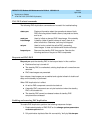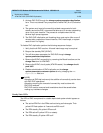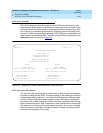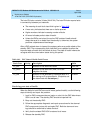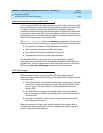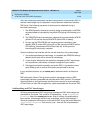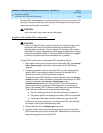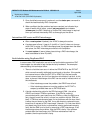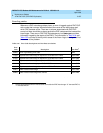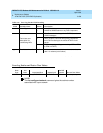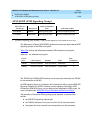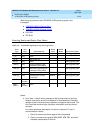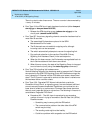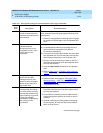
DEFINITY ECS Release 8.2 Maintenance for R8.2csi
555-233-119 Issue 1
April 2000
Maintenance Objects
3-206ATM PNC-DUP (ATM PNC Duplication)
3
5. Once the failed component is replaced, use the
status pnc
command to
check the health standby PNC component.
6. When confident that the problem has been resolved, as indicated by a
state of health with all zeros, unlock (
set pnc unlock
) and release
(
release pnc
) the PNC. Note that no further PNC interchange is required
since you can test the standby PNC as thoroughly as the active.
Interactions: SPE resets and PNC interchanges
■ After a
reset system 4
(reboot), the A PNC is always the active.
■ A system reset of level 1 (warm), 2 (cold2) or 3 (cold1) does not change
which PNC is active. If a PNC interchange was in progress when the reset
took place, the PNC interchange continued until completion.
■ If a
reset system 1
(warm) takes place during a PNC interchange, the
reset is escalated to level 2 (cold2).
Fault isolation using Duplicated PNC
In some cases, PNC duplication can aid in the fault isolation procedure. PNC
interchanges can be used to help isolate the faulty hardware. Two examples
demonstrating this technique follow:
1. There is a fault that can occur in either the PPN ATM-EI or the PKT-INT
which cannot be readily attributed to one board or the other. If the packet
bus transceivers on either the PKT-INT or ATM-EI fail, the two boards
cannot communicate, but it will not be clear which board is at fault. In this
case, a planned interchange of the PNC can be used to indicate which of
the two boards.
— If the interchange cures the problem, the ATM-EI was at fault.
— If the interchange does not cure the problem, the PKT-INT is
suspect, provided there are no PKT-BUS faults.
2. A similar relationship exists for the EPN Archangel (EAA - the active
ATM-EI) and certain TDM bus problems. If the EAA is unable to
communicate with a port board over the TDM bus, either the EAA has a
fault, the port board has a fault, or there is a problem with the TDM bus
itself. If TDM bus maintenance tests find no problems with the bus, then it
is either the port board or the EAA. It may be simpler to replace the port
board than to request a PNC interchange. However, if it is not clear which
port board may be at fault or maintenance is being performed remotely,
verify that the EAA is not at fault by executing a PNC interchange. If the
interchange solves the problem, then the EAA is faulty. If the problem
persists after the interchange, but TDM bus maintenance finds no
problem, then the port board is faulty.




